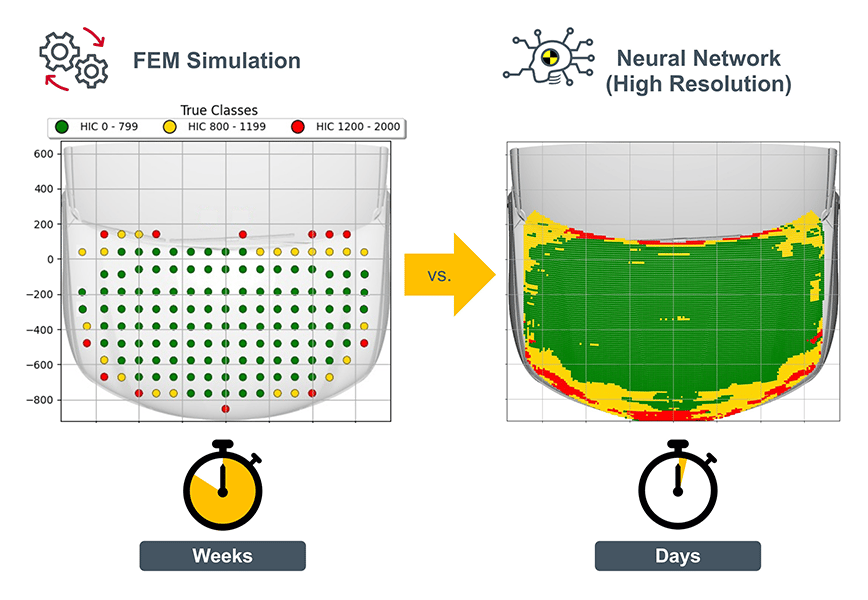Every year, complex crash tests are carried out on new vehicles to test their safety. During these, an important role is played by the risk of injury to pedestrians and cyclists. The amount of time and effort that goes into developing a "pedestrian-compatible" vehicle front end is enormous. But there is also a far more efficient way. Namely the AI Crash tool, which uses artificial intelligence instead of massed computing power.
We have automobile associations such as the ADAC, for example, to thank for the fact that the consequences of car accidents involving pedestrians and cyclists are now no longer as serious as they were 25 years ago. Using crash test scenarios in which, among other things, the effects of adults and children impacting the hood are simulated, they drew attention to their concerns. Following this, the lawmakers also reacted, with the result that vehicles became more "pedestrian-compatible" and injuries to pedestrians were avoided or at least no longer as serious.
Safety-relevant front end
Vehicle manufacturers, therefore, cannot afford not to take pedestrian protection seriously, since this could lead to problems with homologation (vehicle type approval) by the relevant authorities. And if they do, they are also penalized in crash tests by private institutions, as they are refused the top five-star rating in consumer protection tests in line with Euro NCAP standards. Test results like the ones published by the ADAC each year, for example, are an important sales argument here.
The hood plays a decisive role in both the head impact and pelvic impact tests. Factors such as deformation capacity or energy-absorbing structures determine how high the risk of injury is when a person is hit. To avoid unpleasant surprises when at the end it comes to proving that the vehicle complies with all legal requirements, the pedestrian compatibility of its front end is analyzed in the early stages of car development.
High outlay in terms of time and money
Traditionally, the risk of injury is calculated in hardware tests or by means of the finite element method (FEM), which simulates how loads, forces and boundary conditions affect the vehicle structure and the person involved in the impact. Between 200 and 600 FEM simulations need to be calculated for just one geometry/development stage to determine the defined impact points on the front end of a single vehicle. Data preparation, calculation in a high-performance computing (HPC) center, validation of the results and any recalculation necessary usually takes some four to six weeks. On top of this must be added the high cost of the software and computing resources used.
Another problem is that the development of the vehicle continues unabated during this phase. If, during the FEM analysis, it turns out that the front end fails to meet the safety requirements, the development has to be turned back to some degree – as a result of which valuable working time is wasted, or additional time and effort need to be put in to keep to the agreed schedule.
AI for greater speed and efficiency
EDAG has therefore been looking for ways of making the development process more stringent and cost-effective. The result is "AI Crash", an artificial intelligence (AI-)based tool which delivers results within a day or two, rather than weeks. Since it is based on data processing using a neural network instead of massed computing power, this also means lower license and utilization costs for software and server capacities. The analysis no longer depends on access to a data center, but can be carried out on a mobile workstation, for example. 
Another advantage is that instead of being restricted to the raster specified in the homologation process, AI Crash can realize a much finer resolution. This rules out the possibility of undetected problem areas which might pose a higher risk of injury and result in unexpectedly poor crash test results.
Wide range of applications
Critics might now argue that, being based on mathematics and physics, the FEM method is more accurate than the neural black box, which essentially reflects the wealth of experience of a development engineer with a long track record. However, at EDAG, we are certain that the results are sufficiently valid and therefore have no qualms about comparisons being made. Vehicle developers interested in AI Crash can arrange a test run with EDAG to compare their existing FEM calculations with the results of artificial intelligence.
In actual fact, the neural network on which AI Crash is based originates from image processing, but has been expanded to include an analysis of the physics involved. This combination opens the way to a wide range of applications. This framework can also be used to effectively answer other questions in the field of 3D free-form geometry: occupant protection, for instance, as required by US consumer protection law, or the stability of surfaces such as the car roof or hood.
Where in vehicle development are you being held back by lengthy, expensive FEM processes? Contact Friedemann Voit, Head of CAE & Safety at the EDAG Group. Or download our white paper "The Smart Route to Five-Star Tests" here. Further details of how "AI Crash" works and the cost advantages it offers can be found here. 





